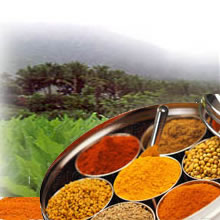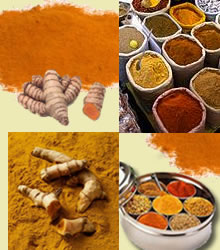Turmeric Spice : | The Golden Spice of Life | Spice Description | Main constituents | Varieties | Major Exporters |
|
Major Importers | Major Trading Centers in India | Production of Turmeric in India |
Turmeric - The Golden Spice of Life
Turmeric is a very important spice in India from ancient times. 
India produces nearly whole world’s turmeric crop and consume 80% of it. With its inherent qualities, Indian turmeric is considered the best in the world. The fresh spice is much preferred to the dried in South East Asia, The fresh rhizome is grated and added to curry dishes; it is also used as yellow curry paste in Thailand. Due to Indian influence, turmeric has also made its way to the cuisine of Ethiopia. Besides flavoring food, to purify the blood and remedy skin conditions is the most common use of Turmeric in Ayurveda.
A yellow spice with a warm and mellow flavor, turmeric is related to ginger. Modern Indian cooking employs turmeric liberally. It is added to nearly every dish, be it meat or vegetables. Yellow rice is popular on the Eastern islands of Indonesia; it derives its colour from fresh or dried turmeric. Western cuisine does not use turmeric directly, but it forms part of several spice mixtures and sauces; it is also used to impart a bright yellow colour to mustard paste.
Turmeric is an important spice for many vegetable curries, rice preparation and other dishes. In some part of India, turmeric root is used to make a tasty vegetable dish. It is a most important spice in Indian recipes.
Hindi Name: Haldi
Botanical name: Curcuma longa L
Family name: Zingiberaceae
Turmeric has been used medicinally throughout Asia to treat stomach and liver ailments. It is a natural blood purifier. It is also used externally, to heal sores, as a cosmetic and for many other health benefits; it aids digestion, and helps to fight against infection and many more…
Turmeric – More of a Medicine than Spice
Spice Description
Turmeric, basically a tropical plant of ginger family is the rhizome or underground stem, with a rough, segmented skin. The length of main rhizome is approximately 2.5 - 7 cm (1 - 3 inches) in length with a diameter of 2.5 cm (1 inch), with smaller tubers branching off. The color of rhizome is yellowish-brown with a dull orange interior and color of powder is bright yellow.
Color: Bright yellow
Flavor & Aroma: Earthy aroma and a pungent, slightly bitter flavor
Bouquet: Earthy and slightly acrid
Main constituents
- Turmeric contains an essential oil max. 5%, this contains a variety of sesquiterpenes specific for the species.
- In turmeric most important for the aroma are
- Turmerone: Max. 30%
- Ar-turmerone: 25%
- Zingiberene: 25% - Conjugated Diarylheptanoids are responsible for the orange colour and probably for the spicy taste (3 - 4%).
Varieties
Some famous varieties of Turmeric are Local Haldi, China scented, Thodopuza, Red streaked, Alleppey. In which Alleppey is more popular in American Markets. It is deeper in color and more flavorful.
Major Exporters of Turmeric
- India - largest exporter (approximately 90%) of Turmeric
- Thailand and other Southeast Asian countries
- Taiwan
- Various Pacific islands
- Central and Latin American countries
Major Importers of Turmeric
- Japan

- Sri Lanka
- Iran
- United States
- United Kingdom
- Middle Eastern countries
- North African countries
- Ethiopia
Major Trading Centers in India
- Nizamabad
- Dugirala (Andhra Pradesh)
- Sangli (Maharashtra)
- Coimbatore (Tamilnadu)
- Salem
- Erode
- Dharmapuri
Production of Turmeric in India
India is the world's largest producer of turmeric, i.e. nearly 90% of the world's total production. The productions of Turmeric in major states of India are as follows:
- Tamilnadu: 18%
- Orissa: 7%
- West Bengal: 4%
- Karnataka: 4%
- Gujarat: 2%
- Maharashtra: 2%
- Kerala: 2%
Harvesting season: December to March
Marketing season: February to May